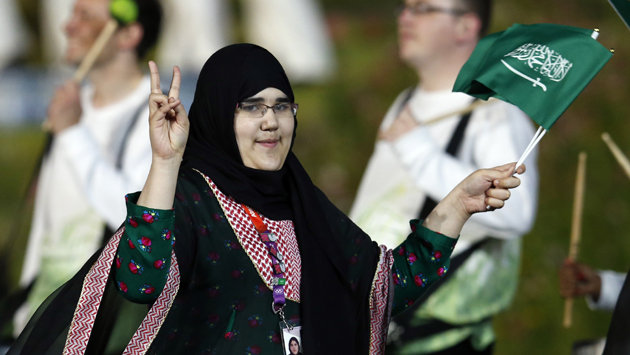 Originally posted at American Thinker. Blog
Originally posted at American Thinker. Blog
The Summer 2012 Olympics in London are supplying the world with exactly the type of ethnic variety that multicultural globalists currently hold in such high esteem. Face it, where else can Olympic fans see female competitors play beach volleyball in orange string bikinis and then be treated to the spectacle of a heavyweight judo competitor from Saudi Arabia rolling around on a mat in a hijab?
That’s right – for the first time ever, the Kingdom of Saudi Arabia has agreed to send female athletes to compete in this year’s Olympics. The competitors are jujitsu champ Wojdan Ali Seraj Abdulrahim Shaherkani and a Pepperdine University 800-meter track and field runner with dual citizenship named Sarah Attar.
If a woman with a bare head disturbs Muslim sensibilities, all praise goes to Allah that the female Saudi delegation didn’t pick beach volleyball as a sport. After all, London Mayor Boris Johnson says that the London beach volleyball players “Glisten like wet otters.” To the delight of male admirers, the British team works the volleyball while “Cheerleaders dance the conga between points, sand sweepers are greeted by the Benny Hill theme song ‘Yakety Sax,’ and the female athletes leave little to the imagination in eye-catching skimpy uniforms.”
Yet, despite the unenticing idea of a sweaty woman running track and field in a layered skull cap, long sleeves and wind-defiant trousers, both Sarah and Wojdan have a unique opportunity to pave the way for the women of Saudi Arabia to get in touch with their inner Venus Williams.
And while being called a “glistening otter” may be a compliment to some, to others being a Saudi female allowed to compete in the Olympics is much more impressive, because back home under the Custodian of the Two Holy Mosques, King Abdullah bin Abdulaziz al Saud, millions of women cannot “watch or play sports.”
Which may be why Sarah and Wojdan’s permission to compete hinged solely on their agreeing to strictly adhere to the “kingdom’s conservative Islamic traditions, including wearing a headscarf.” For Sarah, other than her hijab flying off her head and tangling around the legs of some unsuspecting runner, her sports gear wasn’t a problem.
On the other hand, the Judo Federation is probably wishing Wojdan was a synchronized diver, because attempting to execute a smooth judo move while accessorizing the gi with a hijab violates the “principles of judo and raised safety concerns.”
Historically, judo is considered an art form that “enables its practitioners to gain self-respect, self-confidence, and self-expression; as a science, it involves a mastery of such basic natural laws as gravity, friction, momentum, weight transmission, and unity of forces.” The Judo Foundation probably never anticipated adding ‘hijab mastery’ to the list of natural laws.
Nevertheless, caught between Mecca and a tatami, the Judo Federation caved to Islamic fundamentalism and agreed that Shahrkhani could compete in a “modified version of the hijab.” The main goal was to not disappoint a stocky-but-enthusiastic 18-year-old Saudi judo competitor who saw herself as a female emancipator trailblazing her Saudi self across a judo mat.
The problem is that in Saudi Land, the word “modified” smacks of compromise, and any form of hijab compromise poses a problem for both male and female “hard-liners” who believe that anything “modified” would not provide the ample Wojdan ample modesty.
Worse yet, Shahrkhani dishonoring herself by grappling in a “modified” judogi could result in the woman returning home to a fate worse than choking herself or some other poor soul to death on a yard of material.
Which raises the question: How and why did the wide-faced teenager, waving the green flag with a sword emblazoned on it that says “There is no god but God and Muhammad is the messenger of God” make it to the Olympics? That is the question being asked by Hungarian judo fighters Eva Csernoviczki and Abigal Joo and American gold medal winner Kayla Harrison.
In judo circles, it is common knowledge that Wojdan, accepted despite lack of experience, is not “nearly at the level of the other Olympians — a blue belt in which everyone else owns a high-level black belt.” A former medalist called Ms. Shahrkhani a “novice,” while another contender warned that “judo fighters are not trained to go easy,” especially on a heavyweight neophyte attempting to gain an advantage at the Olympics by choking seasoned athletes into submission with religious headgear.
In addition, a hijab could also be an extreme danger for Shahrkhani. If, while executing complicated grappling maneuvers, her headscarf is unintentionally knocked off, “hard-liners [could] see her as having dishonored herself” which, upon returning home to the Kingdom, would guarantee the type of one-woman tickertape parade that would result in Shahrkhani never requiring a hijab again.
So what’s a girl like Shahrkhani to do? Well, the aim of judo is to throw opponents “flat on their back or pin them to the ground for 25 seconds” which, sorry to say, based on the controversial judoka’s bounteous body weight might be an easy feat regardless of what she’s got wrapped around her noggin.
With that in mind, if Wojdan is determined to compete she should just hang in there. If the Judo Federation fears becoming the object of a future fatwa, in the end Wojdan may be the last judoka standing and take home the gold by Harai Goshi-ing (Sweeping hip-throw) her way into a sanctioned hijab strangulation hold.
Either way, for bravely coming to London and demanding to wear a hijab while competing in a sport that includes pulling on clothing, Shahrkhani is being viewed by Fawaz A. Gerges, director of the Middle East Center at the London School of Economics, as a “pioneer” and one “tough cookie.” Fawaz maintains “When we look back on this Olympics, we will say that moment in London was a historic step forward for Saudi women and their place in society.”
Or maybe the world will see it as the turning point in Olympic history, where pious Wiccans will thank Wojdan Ali Seraj Abdulrahim Shaherkani for paving the way for nude Olympic shot-putting.

